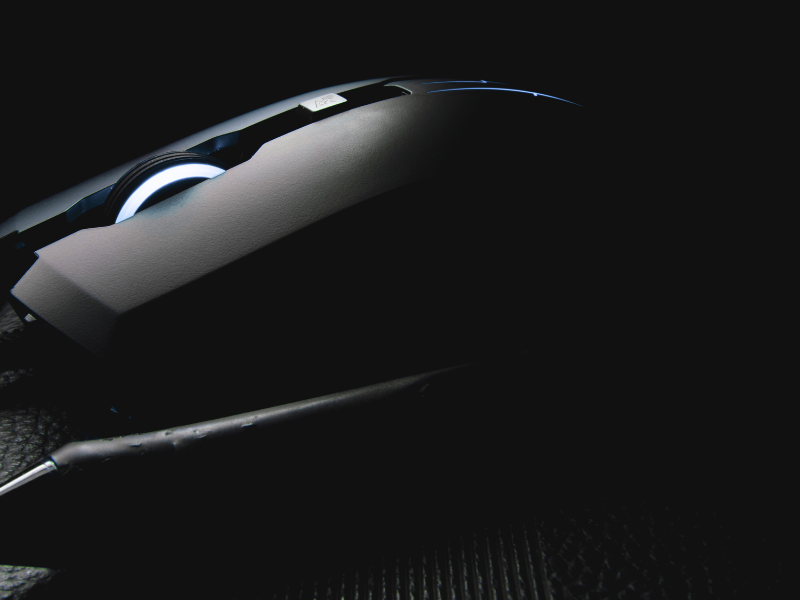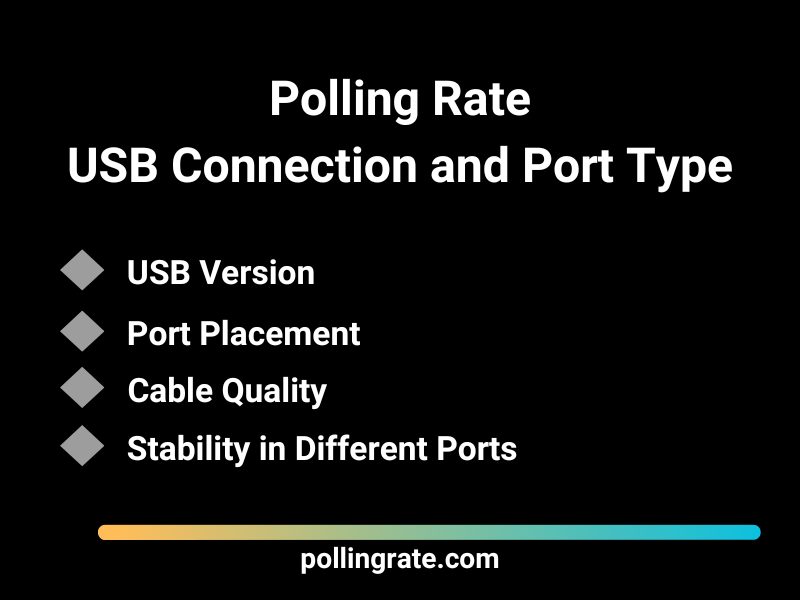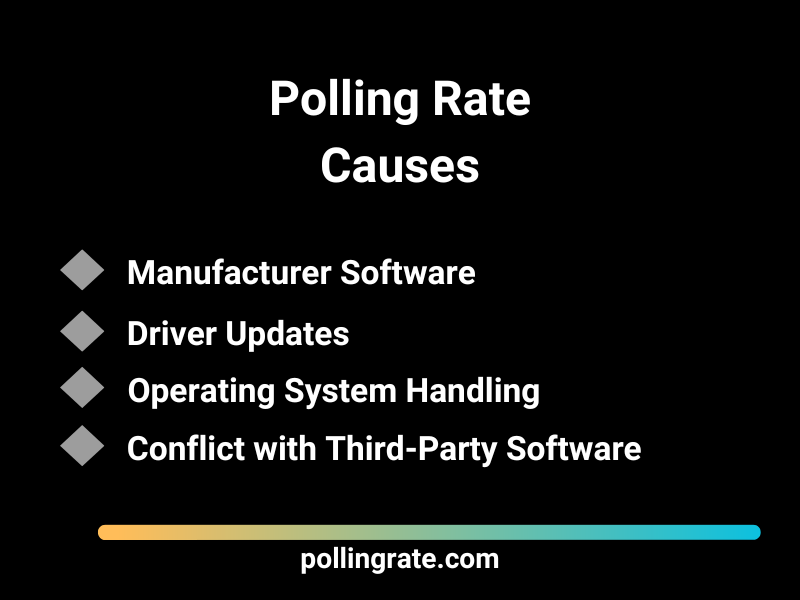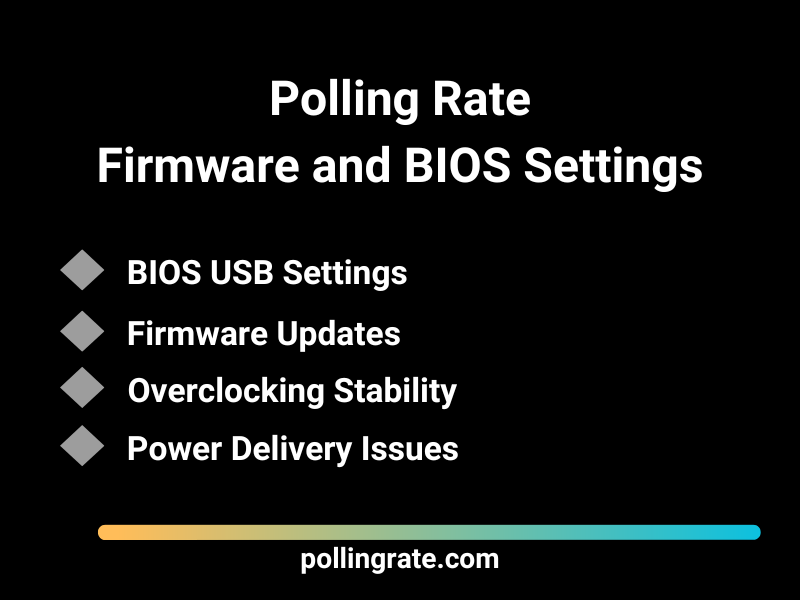Polling Rate Causes – Understanding What Affects Your Device’s Performance
Polling rate plays a critical role in how responsive your gaming mouse or input device feels — but what actually affects it?
In this guide, we break down the main polling rate causes and what can impact the stability and consistency of your device’s signal. Whether you’re a competitive FPS player, an esports professional, or just a tech enthusiast looking to optimize your gear, understanding these factors can help you make smarter decisions and eliminate hidden sources of lag.
✅ USB Port Type and Controller Quality
Not all USB ports are created equal. The type (USB 2.0 vs 3.0 vs 3.1) and the quality of the motherboard’s USB controller can directly affect your device’s ability to maintain high polling rates like 1000Hz or 8000Hz.
✅ Cable Quality and Signal Integrity
Cheap or poorly shielded cables can introduce interference, signal degradation, or unstable power delivery — all of which can reduce polling rate stability, especially under stress.
✅ Drivers, Firmware & Software Conflicts
Outdated or poorly optimized mouse drivers, firmware bugs, and background software can throttle polling rate performance. Always make sure your gear’s firmware is up to date and that any configuration software is optimized for performance rather than aesthetics.
✅ System Load and CPU Prioritization
A high CPU load or inefficient system resource allocation can cause polling rates to spike or drop, especially if USB interrupts are being delayed or deprioritized during intense multitasking or gaming sessions.
✅ Operating System Settings and Power Plans
Default OS power settings often prioritize energy efficiency over performance. To maintain a stable high polling rate, it’s critical to use high performance mode and fine-tune USB power management settings in Windows or macOS.

Tip: Take your competitive gaming to the next level with our top recommendation on Amazon (Affiliate Link)!
Polling Rate Causes - Hardware Limitations
The polling rate of a device is fundamentally tied to its hardware capabilities. Some key factors include:
Sensor Technology: High-end sensors in gaming mice support higher polling rates, while budget models may be limited to 125Hz or 500Hz.
Processor Power: Some mice and keyboards have built-in processors that handle high polling rates efficiently, whereas older or cheaper models may struggle to maintain consistency.
Switch Type: Mechanical keyboards often handle high polling rates better than membrane keyboards due to faster actuation speeds and more reliable keystroke registration.
Internal Memory: Some gaming peripherals store settings internally, ensuring a stable polling rate without relying on software adjustments.
Estimated Polling Rate by Factor:
| Factor | Description | Polling Rate |
|---|---|---|
| Sensor Technology | High-end sensors in gaming mice support higher polling rates; budget models may be limited to 125Hz or 500Hz. | 125Hz–8000Hz |
| Processor Power | Built-in processors help maintain high polling rates; older/cheaper models may struggle with consistency. | 500Hz–8000Hz |
| Switch Type | Mechanical keyboards handle high polling rates better due to faster actuation and reliable keystroke registration. | 1000Hz–8000Hz |
| Internal Memory | Stores settings internally, maintaining stable polling without relying on software. | Stable at 1000Hz+ |
Sensor Technology
High-end sensors in gaming mice support higher polling rates; budget models may be limited to 125Hz or 500Hz.
Polling Rate: 125Hz–8000HzProcessor Power
Built-in processors help maintain high polling rates; older/cheaper models may struggle with consistency.
Polling Rate: 500Hz–8000HzSwitch Type
Mechanical keyboards handle high polling rates better due to faster actuation and reliable keystroke registration.
Polling Rate: 1000Hz–8000HzInternal Memory
Stores settings internally, maintaining stable polling without relying on software.
Polling Rate: Stable at 1000Hz+Polling Rate Causes - USB Connection and Port Type
The type of USB connection used can significantly affect polling rate performance:
USB Version: USB 3.0 and higher provide more stable power and bandwidth, ensuring a consistent polling rate. Older USB 2.0 ports may cause slight delays or fluctuations.
Port Placement: Devices plugged into a motherboard’s direct USB ports generally perform better than those connected via external hubs, which may introduce latency.
Cable Quality: Poorly shielded, damaged, or excessively long cables can introduce latency and instability, affecting polling rate consistency.
Polling Rate Stability in Different Ports: Some motherboard USB ports may not be optimized for high-frequency polling rates, leading to varying results based on where your device is plugged in.

Network-Related Polling Rate Causes
In networked environments, especially in online gaming or remote desktop applications, polling rates can be affected by latency, jitter, and packet loss. These network conditions are significant polling rate causes, as they impact how frequently and reliably input data is transmitted and received. Even with high local polling rates, poor network performance can negate the benefits by introducing noticeable lag or input delays.
Manufacturer Software: Many gaming peripherals come with software that allows users to adjust polling rates. Incorrect settings may cap performance unintentionally.
Driver Updates: Outdated or buggy drivers can introduce latency, reducing effective polling rates and causing inconsistency.
Operating System Handling: Some operating systems prioritize different device interactions, which may cause fluctuations in polling rate performance.
Conflict with Third-Party Software: Certain background applications, such as macro recorders or overlay software, may interfere with how frequently your device reports data to the system.

Polling Rate Causes - System Performance and CPU Load
High CPU usage or limited system resources can contribute to inconsistent input behavior. When the system is under heavy load, it may not prioritize device polling, leading to delays or irregular updates. In such scenarios, system bottlenecks become one of the overlooked polling rate causes, especially in gaming or high-performance environments where consistent responsiveness is crucial.
Background Processes: High CPU usage from other applications can interfere with consistent polling rates. Reducing unnecessary processes can improve stability.
Game Optimization: Some games may cap polling rates internally, limiting responsiveness despite hardware capabilities.
Power Settings: Power-saving modes on laptops or desktops can reduce device polling frequency to conserve energy, potentially causing delays.
Multi-Tasking Impact: Running multiple high-demand applications simultaneously may introduce polling rate inconsistencies due to increased CPU load.
| Factor | Description | Polling Rate |
|---|---|---|
| Background Processes | High CPU usage from other applications can interfere with consistent polling rates. Reducing unnecessary processes can improve stability. | Variable, may drop below 500Hz |
| Game Optimization | Some games may cap polling rates internally, limiting responsiveness despite hardware capabilities. | Often limited to 1000Hz |
| Power Settings | Power-saving modes can reduce polling frequency to conserve energy, potentially causing delays. | Down to 125Hz in power save |
| Multi-Tasking Impact | Running multiple high-demand applications can cause polling inconsistencies due to increased CPU load. | Fluctuates 500Hz–1000Hz |
Background Processes
High CPU usage from other applications can interfere with consistent polling rates. Reducing unnecessary processes can improve stability.
Polling Rate: Variable, may drop below 500HzGame Optimization
Some games may cap polling rates internally, limiting responsiveness despite hardware capabilities.
Polling Rate: Often limited to 1000HzPower Settings
Power-saving modes can reduce polling frequency to conserve energy, potentially causing delays.
Polling Rate: Down to 125Hz in power saveMulti-Tasking Impact
Running multiple high-demand applications can cause polling inconsistencies due to increased CPU load.
Polling Rate: Fluctuates 500Hz–1000HzPolling Rate Causes - Wireless vs. Wired Devices
One of the most common polling rate causes lies in the type of connection a device uses. Wired devices typically offer more stable and higher polling rates due to direct data transmission with minimal latency. In contrast, wireless devices may suffer from signal interference, latency, or battery-saving mechanisms that reduce the effective polling rate. These factors make connection type a key element when diagnosing input lag or inconsistent responsiveness.
Signal Interference: Other wireless devices, such as Wi-Fi routers, Bluetooth peripherals, and even microwaves, can introduce latency and disrupt polling rate stability.
Battery Efficiency: To conserve power, some wireless mice automatically lower their polling rates when battery levels drop, leading to variable responsiveness.
Connection Stability: While some high-end wireless devices achieve 1000Hz polling rates, they are generally more prone to inconsistencies compared to wired counterparts.
Dongle Placement: USB receiver placement can impact signal strength. Keeping the receiver close to the mouse reduces lag and ensures a stable connection.
Firmware and BIOS Settings (Polling Rate Causes)
Low-level system settings can also impact polling rate stability:
BIOS USB Settings: Some motherboards allow adjusting USB polling rate settings, which may enhance or limit performance.
Firmware Updates: Manufacturers release firmware updates that may improve polling rate stability and fix bugs that cause irregular input delays.
Overclocking Stability: If a system is overclocked aggressively, it may introduce inconsistencies in device performance, including polling rate drops and occasional stutters.
Power Delivery Issues: Some motherboards regulate power differently across USB ports, which can affect the polling rate of connected devices.

Environmental and Physical Factors
Environmental and physical factors can significantly affect input performance. Variations in temperature, humidity, and electromagnetic interference can influence how consistently and accurately a device reports its status. These elements are often overlooked but can be among the polling rate causes that lead to inconsistent or degraded performance, particularly in sensitive or high-speed applications.
Lastly, physical conditions and environmental factors can play a role in polling rate inconsistencies:
Dust and Dirt: Debris in sensor areas or mechanical switches can affect device accuracy and response time, leading to inconsistencies in input registration.
Surface Type: Optical mice perform differently on various surfaces, affecting how accurately the polling rate translates into movement. A high-quality mouse pad can significantly improve stability.
Temperature and Humidity: Extreme temperatures can affect electronic performance, including how polling rates are processed, potentially leading to variations in device behavior.
Mechanical Wear and Tear: Over time, switches in keyboards and mice degrade, leading to slower actuation speeds and inconsistencies in polling rate performance.
Dominate Every Match with These Ultra-Responsive Gaming Devices
In fast-paced gaming scenarios, every millisecond matters. The polling rate—how frequently your device updates your PC with input data—can be a game-defining factor. A higher rate ensures quicker signal transmission, smoother movements, and more immediate reactions.
Learning how polling rate works and how to fine-tune it is one of the simplest yet most effective ways to improve gaming performance—without upgrading your entire rig.
🔥 Top Gaming Gear with Ultra-High Polling Rates 🔥
🖱️ Razer DeathAdder Elite Gaming – on Amazon* (Affiliate Link)
A long-time favorite in competitive gaming, the DeathAdder Elite features a 1000Hz polling rate for lightning-fast responsiveness. Paired with a 16,000 DPI sensor and a comfortable ergonomic shape, it delivers reliable accuracy for extended play sessions.
⌨️ Razer Huntsman V3 Pro Mini Gaming Keyboard – on Amazon* (Affiliate Link)
This compact 60% keyboard is engineered for performance, featuring Rapid Trigger Optical Switches and a 1000Hz polling rate. It registers each keystroke almost instantly—ideal for competitive FPS and fast-paced esports titles.
📺 Acer XV272U 27″ WQHD 240Hz IPS Gaming Monitor – on Amazon* (Affiliate Link)
Sporting a 240Hz refresh rate, 0.5ms response time, and FreeSync support, this monitor delivers crisp visuals and fluid motion. Perfectly complements high polling rate gear for a latency-free experience.
🖱️ Razer Viper V3 Pro Wireless (8000Hz) – on Amazon* (Affiliate Link)
Looking for the fastest wireless mouse on the market? With support for a blazing 8000Hz polling rate via HyperPolling Dongle (sold separately), the Viper V3 Pro delivers elite-level speed in a featherweight frame, trusted by top esports pros.
🎮 Why Polling Rate Is a Game Changer
A 1000Hz device updates every 1ms, but newer 8000Hz options cut latency dramatically. Paired with high-refresh monitors and optimized input devices, this translates to sharper movement, faster reactions, and pinpoint aim in high-speed competitive titles.
Final Thoughts – Polling Rate Causes
If your inputs feel inconsistent, delayed, or simply off, your polling rate might be the root of the problem—but the cause isn’t always obvious. Many gamers assume their mouse or keyboard is the issue, but in reality, polling rate is shaped by a combination of hardware and software factors that need to work together seamlessly.
Your USB controller, motherboard chipset, device firmware, and even the quality of the cable or port you’re using all influence how consistently your device can send input signals. Add in background processes, driver conflicts, outdated firmware, or power-saving settings, and it’s easy to see how polling rate stability can fall apart—even on high-end setups.
Environmental conditions can also play a role. Using an underpowered USB hub, connecting through long or damaged cables, or running too many devices through the same controller can all throttle your device’s communication rate, leading to input delay, stutter, or signal drops.
At InputDelay.com, we’ve spent time identifying not just how to fix polling rate issues—but what causes them in the first place. Understanding these sources helps you go beyond surface-level fixes and build a more stable, low-latency system that performs reliably under pressure, whether you’re competing in ranked matches or editing high-precision creative work.
Want to fully stabilize your polling rate and eliminate the hidden causes of input delay? Check out our Ultimate Guide for advanced tips and real-world solutions.
